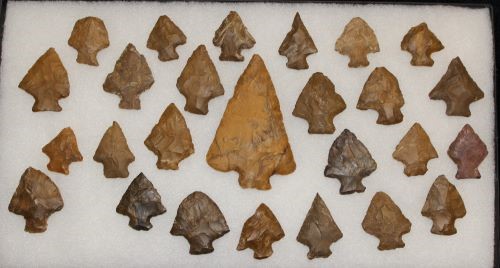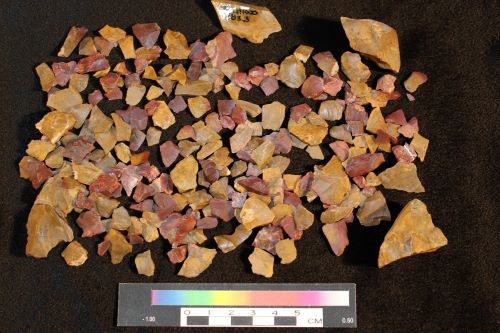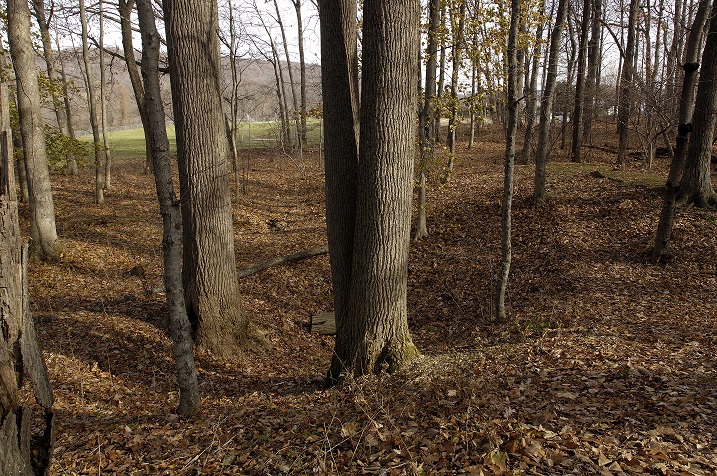Happy Archaeology Month!
One of the most common objects shown to archaeologists for identification are rocks. Most of the time, these objects just end up being rocks, but sometimes people do find one that has been altered in some way by human hands. These artifacts are called lithics and they can be found all over the United States and throughout the rest of the world.
Out of all the different types of lithic artifacts, most people are familiar with arrowheads (or projectile points) like these jasper Perkiomen/broadspear projectile points

Riker mount full of jasper Perkiomen/broadspear projectile points. Source: State Museum of Pennsylvania; Dave Burke, photographer; 2023.
Before the invention of metal tools, lithic tools were used by cultures worldwide to help with hunting, processing food, building structures, processing plant material for baskets, and turning plants into fiber used to make cloth materials.
However, before a stone tool can be used to perform one of the useful tasks listed above, it takes a skilled individual to pick the perfect raw material, clean it up, and shape it into the lithic tools that many of us know and love.

Spread of Jasper Debitage from southeastern PA. Source: State Museum of Pennsylvania; Dave Burke, photographer; 2023.
Quarry Sites
Once a spot is known to yield workable material, people would have spent time at these locations extracting these raw materials for themselves or for trading with others. This process creates a quarry site.
There are quarries all over the US—ones that have been created by present-day companies to extract different types of resources, and ones that were created by Indigenous peoples before the arrival of Europeans to North America. While Pennsylvania is no stranger to present-day quarrying activity, there are quarries that were made by the Indigenous occupants of this land in their pursuit of raw material more than 10,000 years ago.
Jasper is one type of workable material that was used in the production of stone tools by the Indigenous occupants of southeastern Pennsylvania. The jasper quarry sites in southeastern Pennsylvania have been the subject of study for many years, with the earliest investigations being carried out by Henry Mercer in the 1800s. One such examination of jasper quarries in southeastern Pennsylvania has focused on the Hardyston jasper quarries. These quarry sites tend to follow a jasper seam within the Hardyston formation.
So, why does PA-SHPO care about these quarry and quarry-related sites in southeastern Pennsylvania?
Well, apart from caring about all the cultural resources throughout the state, these quarry sites are in areas that are desirable for development and are increasingly endangered. In fact, these site types were so commonly encountered during the development of Interstate 78, PennDOT sponsored a publication to examine and document these precontact quarry sites in 1988.

Precontact jasper quarry pit in southeastern PA. Photo by Don Giles, PHMC, 2005.
The authors of the 1988 report, David Anthony and Daniel Roberts, defined the boundaries and criteria that compose what they called the Hardyston Jasper District. At that time Anthony and Roberts identified 176 precontact (meaning before the arrival of Europeans) archaeological sites, with distribution across southeastern Pennsylvania.
These 176 sites consist of more than just quarry sites. Sites range from quarry sites to lithic production sites (where lithic material would have been knapped into tools).
Archaeological sites and other properties that are considered important in some way to the nation’s history can be listed on the National Register of Historic Places. There are four criteria that are used to determine the significance of a site or property. For this project, sites are being evaluated based on their ability to yield or be likely to yield information important in history or prehistory, also known as Criterion D.
Hardyston Jasper District
For practical reasons, the Hardyston Jasper District was not mapped or defined as an archaeological district in SHPO records. As a result, an undefined number of sites that likely meet the criteria for inclusion in the district were never evaluated.
Because the district is in a region experiencing intense development including roadway and bridge projects, PA SHPO has proposed to reevaluate our PA Archaeological Site Survey (PASS) data to create and formally designate a district, refine the district’s boundaries, and identify and evaluate sites for inclusion in the district. By doing so, we are better able to assist PennDOT and other state and federal agencies with their ground disturbing projects that occur in southeastern Pennsylvania.
This is no easy task—it has involved combing through tons of archaeological reports that have been written since the 1988 report by Anthony and Roberts. We have also had to examine each of the previously recorded sites to see if they can be associated with the Hardyston Jasper District. Despite this monumental task, it is important to have as many of these sites accounted for since they are a significant part of the history of the Hardyston Jasper District.
Keep an eye out for a future blog post which will include updates on PA SHPO’s progress with this project and even highlights from a planned fieldtrip to some of these archaeological sites!
Comment Policy
PHMC welcomes and encourages topic-related comments on this blog. PHMC reserves the right to remove comments that in PHMC’s discretion do not follow participation guidelines.
Commenters and Comments shall be related to the blog post topic and respectful of others who use this site.
Commenters and Comments shall not: use language that is offensive, inflammatory or provocative (this includes, but is not limited to, using profanity, obscene, or vulgar comments); disparage other commenters or people; condone illegal activity; identify the location of known or suspected archeological sites; post personal information in comments such as addresses, phone numbers, e-mail addresses or other contact details, which may relate to you or other individuals; impersonate or falsely claim to represent a person or an organization; make any commercial endorsement or promotion of any product, service or publication.
If you would like to comment on other topics not related to this blog post but related to PHMC, please fill out the PHMC Contact Us Form.
Flats road From Waterford,Pa leading to Mill Village ,Pa intersects with Stone Quarry road and if you drive down a ways it intersects with Dewey Road you can drive down a ways and see the stone quarry`s on the left you have to turn around to get out because the very old iron bridge over French Creek Leboeuf township deemed unsafe The Eagle Hotel In Waterford was built from this quarry along with some old houses in the area